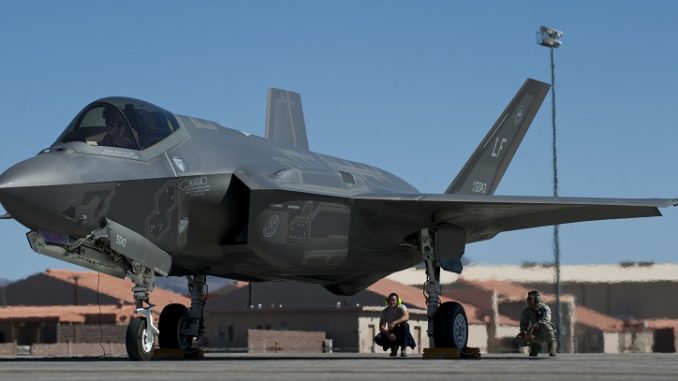
The U.S. government projects the total cost to develop, buy and operate the Lockheed Martin Corp F-35 Joint Strike Fighter will be $1.45 trillion over the life of the aircraft. That is absolutely insane. Most people have no conception of what such a stunning and distressing amount of money that really is. It’s so large, that when we write it down we prefer to abbreviate it, ($1.45 T).
Maybe it would help us if we actually wrote it out; $1,450,000,000,000. If a school lunch is $5.00, the money spent on the F-35 program alone would have purchased 290,000,000,000 school lunches. Instead, we have a fighter weapons system that is severely flawed and places our pilots and our nation in danger.
About a year ago, as Hurricane Michael approached the Florida panhandle, 31 percent of F-22 Raptor aircraft at Tyndall AFB were designated NMC (non-mission capable), meaning they allegedly couldn’t fly and were, “sheltered in place” as the winds of Michael began to rise. So, 17 of 55 F-22 Raptors were left behind to ride out the storm. And, that didn’t go very well.
There were rumors going around that our military brass actually wanted all of the Raptors to be destroyed by an “act of God,” so they could lobby for more money out of the defense budget.
A former Navy sailor told us, “if they would have taken a chainsaw and cut off the wings of each aircraft and placed them on flatbed semitrailers for transport away from hurricane danger area, they would have saved the avionics and many other vital parts contained in the aircraft’s fuselage. Avionics alone are usually 70% (or more) of the cost of the F-22. For some reason, they wanted those aircraft destroyed.”
There is so much fraud, waste and abuse going on in the defense industry, the staggering amount of which, can barely be imagined or described. The greed and corruption is at levels that boggles the mind. Our military members are routinely placed in danger so defense contractors and politicians can rake-in billions of dollars.
Do you really want to encourage your son or daughter to enter military service?
Tyler Durden of ZeroHedge.com clearly states the case about the F-35s …
Two of the three versions of Lockheed’s beleaguered F-35 fighter jet suffer from previously unreported problems that could put the Joint Strike Fighter at a serious disadvantage in a dogfight with an adversary, according to documents obtained by Defense News.
If left unresolved, the following ‘category 1’ glitches will be icing on the cake of Lockheed’s $400 billion quagmire (partial list via Defense News);
- When the F-35B vertically lands on very hot days, older engines may be unable to produce the required thrust to keep the jet airborne, resulting in a hard landing.
- After doing certain maneuvers, F-35B and F-35C pilots are not always able to completely control the aircraft’s pitch, roll and yaw.
- Supersonic flight in excess of Mach 1.2 can cause structural damage and blistering to the stealth coating of the F-35B and F-35C.
- Cabin pressure spikes in the cockpit of the F-35 have been known to cause barotrauma, the word given to extreme ear and sinus pain.
- The spare parts inventory shown by the F-35’s logistics system does not always reflect reality, causing occasional mission cancellations.
- If the F-35A and F-35B blows a tire upon landing, the impact could also take out both hydraulic lines and pose a loss-of-aircraft risk.
- Possible maneuvering issues when the aircraft is operating above a 20-degree angle of attack.
- The F-35’s logistics system currently has no way for foreign F-35 operators to keep their secret data from being sent to the United States.
On that last one – this means that there’s no way that the eleven countries which have committed to buying F-35s will be able to prevent the Untied States from spying on their maneuvers (Sorry Australia, Belgium, Denmark, Italy, Israel, the Netherlands, Norway, Japan, South Korea, Turkey and the United Kingdom).
Of note, the F-35 program had 111 “category 1” deficiencies as of January 2018, defined as major flaws that impact safety or mission effectiveness. By May 24 2018, that had decreased to 64 open category 1 issues out of a total 913 deficiencies according to the documents.

The Pentagon Pushes Back
F-35 DoD program executive Mat Winter told Defense News that none of the identified issues represent any serious or catastrophic risk to pilots, missions or the F-35 airframe.
After being contacted by Defense News, the program office created two designations of category 1 problems to highlight the difference between issues that would qualify as an emergency and others that are more minor in nature.
“CAT 1-As are loss of life, potential loss of life, loss of material aircraft. Those have to be adjudicated, have to be corrected within hours, days. We have no CAT 1-A deficiencies,” Winter said.
Instead, the deficiencies on the books all fall under category 1B, which represents problems “that have a mission impact with a current workaround that’s acceptable to the war fighter with the knowledge that we will be able to correct that deficiency at some future time,” Winter added. -Defense News
Greg Ulmer, Lockheed’s Vice President for the F-35 program, said that F-35s already in the field are meeting or exceeding performance specifications.
“These issues are important to address, and each is well understood, resolved or on a path to resolution,” said Ulmer, adding “We’ve worked collaboratively with our customers, and we are fully confident in the F-35’s performance and the solutions in place to address each of the items identified.”
Of course, acting defense secretary Patrick Shanahan may disagree – reportedly describing the F-35 program as “fucked up,” according to the Washington Post.
Fighter pilots are shaking their heads
Defense News approached two fighter pilots – one retired and one active duty, who offered their perspectives on the F-35.
The recently retired aviator said some of the issues jumped off the page at him, including the cabin over-pressurization issue, given the rash of over-pressurization issues in other aircraft, including the F/A-18E/F Super Hornet, EA-18G Growler and F-22 Raptor.
But perhaps the most serious for aerial combat operations is the combination of maneuvering issues when the aircraft is operating above a 20-degree angle of attack and the issue of possible structural damage and damage to the low-observable coating when using the afterburner. That coating helps provide the F-35 a stealth capability.
“The one that stood out to me was, wait a minute, you’re telling me that the latest, greatest aircraft — [a] $100 million aircraft — can’t perform?” the retired fighter pilot said. “It has random oscillations, pitch and yaw issues above 20A?” -Defense News
The active duty pilot, on the other hand, said that the list of deficiencies weren’t a huge concern, and that given the plane’s relatively recent introduction such problems are inevitable.
“That document looks like growing pains for an aircraft that we tried to do a whole lot to all at once,” said the aviator. “You’re going to see that if you dig back at what Super Hornets looked like for the first few years. Go back in the archives and look at [the F-14] Tomcat — think about that with the variable sweep-wing geometry, the AUG9 radar: There was a lot of new technology incorporated into the aircraft, and there is going to be growing pains.”
“I don’t see anything in that document that makes me say: ‘Holy sh–, what did we buy?’ If the questions is, ‘Why does the aircraft have all these problems?’, I don’t know, it may sound trite, but it’s a really f–ing complicated machine.”




